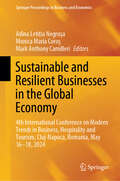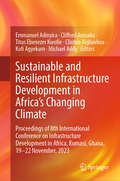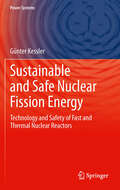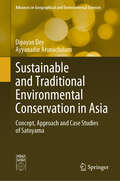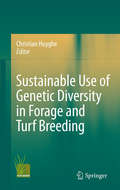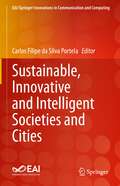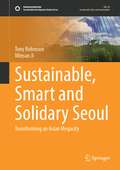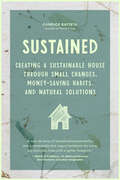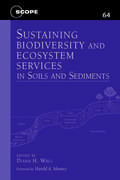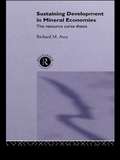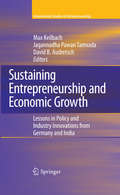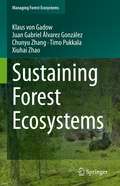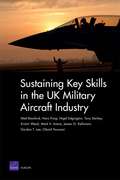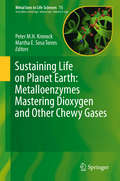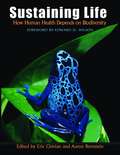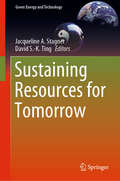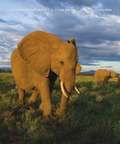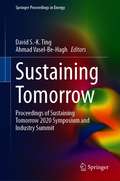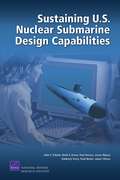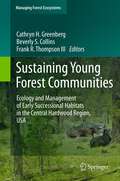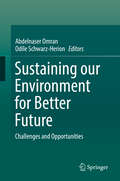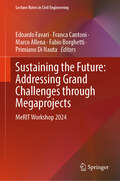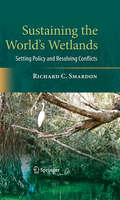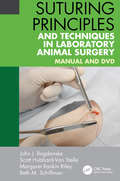- Table View
- List View
Sustainable and Innovative Vegetable Production in times of Climate Change: Concepts of Olericulture
by Zafar Iqbal Sezai Ercisli Muhammad Akbar Anjum Saeed RaufThis contributed book delves into the cutting-edge techniques and sustainable practices essential for vegetable production in times of climate change. It offers a comprehensive exploration of topics such as CRISPR-based gene tweaking, hydroponic systems, organic farming, edible landscaping, indoor vegetables&’ production techniques, vegetable grafting, protected olericulture, value addition and postharvest management. The book covers insights into the nutritive and therapeutic value of vegetables, innovative nursery management, and the latest trends in fresh-cut vegetables. The chapters, contributed by world-renowned experts, address critical questions about food security, environmental sustainability, and advanced cultivation methods. This book is a must-read for anyone looking to enhance their understanding of modern vegetable production. This book is an invaluable resource for agriculturists, horticulturists, food scientists, plant breeders, university scholars, and industry professionals. It provides knowledge on improving practices through eco-friendly techniques. Whether you are a researcher or an avid gardener, this book will equip you with the latest research and practical applications to thrive in the evolving field of olericulture.
Sustainable and Resilient Businesses in the Global Economy: 4th International Conference on Modern Trends in Business, Hospitality and Tourism, Cluj-Napoca, Romania, May 16–18, 2024 (Springer Proceedings in Business and Economics)
by Mark Anthony Camilleri Adina Letiția Negrușa Monica Maria CoroşThis book explores the latest trends, challenges, and opportunities shaping the business, hospitality, and tourism sectors, with a special focus on Eastern Europe. It presents a collection of thought-provoking papers from the 2024 Modern Trends in Business, Hospitality, and Tourism International Conference, held in Cluj-Napoca, Romania. Key topics include the evolution of global capital markets and investment strategies in the post-COVID-19 era, innovative and sustainable business models, alternative financing solutions for SMEs, corporate governance reforms, and the future of human capital leadership. Each chapter offers fresh perspectives on building resilient businesses in an increasingly interconnected global economy. Ideal for academics, researchers, industry experts, and practitioners, this book provides valuable insights and practical solutions for fostering sustainable growth and resilience in today’s dynamic business environment.
Sustainable and Resilient Infrastructure Development in Africa's Changing Climate: Proceedings of 8th International Conference on Infrastructure Development in Africa, Kumasi, Ghana, 19-22 November, 2023
by Clinton Aigbavboa Titus Ebenezer Kwofie Emmanuel Adinyira Clifford Amoako Kofi Agyekum Michael AddyThis book contains the proceedings of ICIDA 2023. The conference is a platform for deliberating the delivery and management of infrastructure in Africa in the face of a changing climate. It helped to engage various stakeholders, in the continent and beyond, on how to develop and deliver sustainable and resilient infrastructure against climate variabilities. This book brings together the experiences, of participants, gathered through many years of research and practice across various fields of infrastructure development that can help shape the future of the African continent.
Sustainable and Safe Nuclear Fission Energy
by Günter KesslerUnlike existing books of nuclear reactor physics, nuclear engineering and nuclear chemical engineering this book covers a complete description and evaluation of nuclear fission power generation. It covers the whole nuclear fuel cycle, from the extraction of natural uranium from ore mines, uranium conversion and enrichment up to the fabrication of fuel elements for the cores of various types of fission reactors. This is followed by the description of the different fuel cycle options and the final storage in nuclear waste repositories. In addition the release of radioactivity under normal and possible accidental conditions is given for all parts of the nuclear fuel cycle and especially for the different fission reactor types.
Sustainable and Traditional Environmental Conservation in Asia: Concept, Approach and Case Studies of Satoyama (Advances in Geographical and Environmental Sciences)
by Ayyanadar Arunachalam Dipayan DeyThis book articulates the traditional Japanese concept of conservation, called Satoyama, for effective management of nature’s goods and services at a community–ecosystem interface in the climate milieu. The term Satoyama refers to socio-ecological production landscapes and seascapes, which are mosaics of diverse land uses and ecosystems that have long been shaped through sustainable human interactions with nature. This multilevel study of conservation science, therefore, serves an interdisciplinary academia, consistent with conventions on climate change, biodiversity and sustainable development, to establish links between conservation priorities and development objectives. In this book, the Satoyama is introduced as a rights-based neo-economic conservation paradigm for production-linked sustainable development, supplemented with case studies from Asia. The International Partnership for the Satoyama Initiative was established at the 10th Conference of the Parties to the Convention on Biological Diversity in 2010 to protect and revitalise Satoyama. However, even after a decade, this panacea for sustainability remains unfulfilled for practitioners and policy planners in the global south. Satoyama have been disappearing as a result of irresponsible consumption of natural resources and drastically changing agro-farming practices, threatening wildlife inhabiting those areas as well as the life and livelihood of marginal communities in the vicinity. In consideration of the global pandemic crisis, the present monograph aims for introspection within a traditional sustainable practice of Asia to augment community resilience and preparedness.
Sustainable use of Genetic Diversity in Forage and Turf Breeding
by Christian HuygheThis book is a collection of papers presented at the 2009 meeting of the Fodder Crops and Amenity grasses section of Eucarpia. It provides a unique source of information on the most recent results on genetic diversity and breeding in forage crops and turf species from Europe and overseas. It is organised in five sections. The first section is devoted to genetic resources which are the source of diversity for breeding but also a source of information for a better preservation of diversity through biogeography approaches. The second section focuses on changes which may occur in grassland and turf swards. These swards are plant communities which are likely to experience species and genetic changes. Population genetics provides keys to understand these changes in order to take them into account during breeding and sward management. The third section documents the genetic gains achieved during breeding while the fourth one gives a detailed presentation of the results and potential of molecular biology to better use the genetic diversity. Eventually, the fifth section investigates the potential of new structures of varieties either exploiting the heterosis or the interspecific hybridization.
Sustainable, Innovative and Intelligent Societies and Cities (EAI/Springer Innovations in Communication and Computing)
by Carlos Filipe da Silva PortelaThis book combines two main topics applied to cities and societies: innovation and sustainability. The book begins by showing a brief overview of the book's main topics; then, the book addresses four main areas which allow our communities to be more attractive, engaging and fun; analytical, descriptive and predictive; healthy, secure and sustainable; and innovative, connected and monitored. This book represents a union of inputs from researchers and practitioners where each chapter has distinct, valuable and practical contributions that turn it unique. The content ranges from theoretical, like studies or analyses to practical, like industrial solutions or engaging systems. Both branches focus on turning our society more attractive, intelligent, inclusive, sustainable, and ready for the future.
Sustainable, Smart and Solidary Seoul: Transforming an Asian Megacity (Sustainable Development Goals Series)
by Tony Robinson Minsun JiThis book showcases how innovative state policy in Korea transformed Seoul from one of the world’s most impoverished, polluted, and congested cities into a global leader in green urban planning, smart city innovations, and social economy initiatives that have dramatically improved the local quality of life. Today, Seoul’s urban planning innovations are increasingly touted as replicable best practices for export to cities across the globe.This book describes how innovative state policy has made Seoul a world leader in sustainable, smart, and solidary urban initiatives. Beginning in the 1960s, Seoul led the fastest urbanization and modernization project in world history, becoming a colossal 26-million-person metropolitan region and one of the largest footprints of humanity on earth, transforming the nation from one of the world’s poorest to having the 10th largest GDP in 2020.Today, Seoul has become one of the most productive and innovative urban agglomerations on earth. Seoul’s residents enjoy the world’s highest penetration of high-speed internet, a model mass transit system, and advanced smart-city technologies. The vast city has become increasingly green and sustainable, while also recycling about 90% of all waste. Seoul has become a leader in social economy innovations like cooperative villages, mutual benefit societies, and social investment funds that advance equitable development goals amid a booming capitalist economy. To broaden our imagination of what good urbanism can achieve, this book reviews Seoul’s recent innovations in smart, sustainable, and solidary urbanism, including: green urban planning, sustainable development through recycling and reuse, well-managed mass transit, smart city design, and solidarity economy initiatives.
Sustained: Creating a Sustainable House Through Small Changes, Money-Saving Habits, and Natural Solutions
by Candice BatistaHelp Save Our Planet with Money-Saving Sustainable Tips for Your HouseHouseholds are among the biggest contributors to global greenhouse gas emissions worldwide. Could the secrets of saving the environment (and money) be closer to home than we thought?Looking for easy, budget-friendly ways to reduce your environmental impact and save money? Authored by award-winning environmental journalist, Candice Batista, Sustained takes you on an eye-opening journey towards sustainability and eco-friendly living─starting at home. This step-by-step, eco-living guide offers simple yet powerful ways to turn each room in your home into a hub of sustainability, while pocketing impressive savings every step of the way.Small changes, big impact. Starting with a deep dive into how our actions at home impact the planet, Sustained offers a practical suite of never-before-seen tools and solutions to initiate the shift towards a greener lifestyle–without draining your time, energy, or budget.Inside find:Eye-Opening Ideas: Explore green cleaning alternatives, ethical fashion brand recommendations, kitchen composting and waste management advice, laundry routine overhaul guidance, and more.Cleaner and Greener: Reduce your dependence on chemical products and single-use plastics, decipher cryptic food and fashion labels, shop like an eco-pro, and make room for a new lifestyle that’s kinder to you, your pocket, and the planet.Eco-Living Simplified: Going green doesn’t have to push your bank account into the red. Uncover tried-and-trusted tips for sustainable living, fresh recipe ideas, and up-to-date insights into top-rated biodegradable home products.Environmentally conscious readers of sustainability books like Simply Living Well, The Backyard Homestead Bible, or Sustainable Minimalism, will love Candice Batista's Sustained.
Sustaining Biodiversity and Ecosystem Services in Soils and Sediments (SCOPE Series #64)
by Diana H. WallSustaining Biodiversity and Ecosystem Services in Soils and Sediments brings together the world's leading ecologists, systematists, and evolutionary biologists to present scientific information that integrates soil and sediment disciplines across terrestrial, marine, and freshwater ecosystems. It offers a framework for a new discipline, one that will allow future scientists to consider the linkages of biodiversity below-surface, and how biota interact to provide the essential ecosystemservices needed for sustainable soils and sediments.Contributors consider key-questions regarding soils and sediments and the relationship between soil- and sediment- dwelling organisms and overall ecosystem functioning. The book is an important new synthesis for scientists and researchers studying a range of topics, including global sustainability, conservation biology, taxonomy, erosion, extreme systems, food production, and related fields. In addition, it provides new insight and understanding for managers, policymakers, and others concerned with global environmental sustainability and global change issues.
Sustaining Development in Mineral Economies: The Resource Curse Thesis
by Richard AutyIt is widely believed that natural mineral resources are desirable. However there is growing evidence that this may not always be the case. Indeed, it seems that natural assets can distort the economy to such a degree that the benefit actually becomes a curse. In Sustaining Development in Mineral Economies, Richard Auty highlights these drawbacks and the devastating effect they can have on developing economies. With reference to six ore-exporters (viz. Peru, Bolivia, Chile, Jamaica, Zambia and Papua New Guinea) he outlines how things can go badly wrong. He particularly stresses the need to avoid `Dutch Disease' whereby competitiveness is drained out of the agriculture and manufacturing sectors so that in the long term growth falters.
Sustaining Entrepreneurship and Economic Growth
by Jagannadha Pawan Tamvada David B. Audretsch Max KeilbachAcademic research on developed countries has scientifically evaluated the role of entrepreneurship on economic growth, market expansion, commercializing innovation, and reducing unemployment. In this research, regions or industries with higher rates of entrepreneurship show higher levels of innovation and economic growth. The literature on entrepreneurship and innovation has largely ignored developing countries, despite the positive results from new venture investments in India, China, and elsewhere. This volume bridges this gap by bringing together research by scholars in Germany and India, whose analysis of entrepreneurship, innovation, and economic development in their respective countries reveals commonalities. Covering such timely issues as R&D and labor policies and including case examples from the chemical, biotech, and IT industries, the authors offer insight into the entrepreneurial process. The volume concludes with a discussion of the global implications for entrepreneurship research and policy.
Sustaining Forest Ecosystems (Managing Forest Ecosystems #37)
by Timo Pukkala Klaus von Gadow Juan Gabriel Álvarez González Chunyu Zhang Xiuhai ZhaoForest ecosystems include a great variety of communities of organisms interacting with their physical environment: multi-aged natural forests, even-aged monocultures, and secondary forests invaded by foreign species. The challenge is to sustain their ability to function, by adapting to changing climates and satisfying a multitude of human demands. Our first chapter sets the scene with a discussion about the effects of forest management on ecosystem services. Details about forest observational infrastructures are introduced in the second chapter. The third chapter presents methods of analysing forest density and structure. Models for estimating the shape and growth of individual forest trees are introduced in chapter 4, models of forest community production in Chapter 5. Methods and examples of sustainable forest design are covered in chapter 6. New scientific contributions continue to emerge as we are writing, and this work is never finished. We hope to continue with regular updates replacing obsolete sections with new ones, but the general aim remains the same, to introduce a range of methods that will assist those interested in sustaining forest ecosystems.
Sustaining Key Skills in the UK Military Aircraft Industry
by Tony Starkey Nigel Edgington Hans Pung Matt Bassford Kristin WeedThe United Kingdom Ministry of Defence's Fixed Wing Sector Strategy Board commissioned RAND Europe to assist in the development of a strategy and sustainment plan for the military fixed wing sector. RAND focused on the health and sustainment of key skills in the sector's industrial base. This monograph describes the qualitative and quantitative methodologies that the RAND team followed and summarises its findings and recommendations.
Sustaining Life on Planet Earth: Metalloenzymes Mastering Dioxygen and Other Chewy Gases
by Martha E. Sosa Torres Peter M. H. KroneckMILS-15 provides an up-to-date review of the metalloenzymes involved in the activation, production, and conversion of molecular oxygen as well as the functionalization of the chemically inert gases methane and ammonia. Found either in aerobes (humans, animals, plants, microorganisms) or in anaerobes (so-called "impossible bacteria") these enzymes employ preferentially iron and copper at their active sites, in order to conserve energy by redox-driven proton pumps, to convert methane to methanol, or ammonia to hydroxylamine or other compounds. When it comes to the light-driven production of molecular oxygen, the tetranuclear manganese cluster of photosystem II must be regarded as the key player. However, dioxygen can also be produced in the dark, by heme iron-dependent dismutation of oxyanions. Metalloenzymes Mastering Dioxygen and Other Chewy Gasesis a vibrant research area based mainly on structural and microbial biology, inorganic biological chemistry, and environmental biochemistry. All this is covered in an authoritative manner in 7 stimulating chapters, written by 21 internationally recognized experts, and supported by nearly 1100 references, informative tables, and over 140 illustrations (many in color). MILS-15 provides excellent information for teaching; it is also closely related to MILS-14, The Metal-Driven Biogeochemistry of Gaseous Compounds in the Environment. Peter M. H. Kroneck is a bioinorganic chemist who is exploring the role of transition metals in biology, with a focus on functional and structural aspects of microbial iron, copper, and molybdenum enzymes and their impact on the biogeochemical cyles of nitrogen and sulfur. Martha E. Sosa Torres is an inorganic chemist, with special interests in magnetic properties of newly synthesized transition metal complexes and their reactivity towards molecular oxygen, applying kinetic, electrochemical, and spectroscopic techniques.
Sustaining Life: How Human Health Depends On Biodiversity
by Edward Wilson Kofi Annan Eric Chivian Aaron BernsteinThe Earth's biodiversity-the rich variety of life on our planet-is disappearing at an alarming rate. And while many books have focused on the expected ecological consequences, or on the aesthetic, ethical, sociological, or economic dimensions of this loss, Sustaining Life is the first book to examine the full range of potential threats that diminishing biodiversity poses to human health. <p><p> Edited and written by Harvard Medical School physicians Eric Chivian and Aaron Bernstein, along with more than 100 leading scientists who contributed to writing and reviewing the book, Sustaining Life presents a comprehensive--and sobering--view of how human medicines, biomedical research, the emergence and spread of infectious diseases, and the production of food, both on land and in the oceans, depend on biodiversity. The book's ten chapters cover everything from what biodiversity is and how human activity threatens it to how we as individuals can help conserve the world's richly varied biota. Seven groups of organisms, some of the most endangered on Earth, provide detailed case studies to illustrate the contributions they have already made to human medicine, and those they are expected to make if we do not drive them to extinction. Drawing on the latest research, but written in language a general reader can easily follow, Sustaining Life argues that we can no longer see ourselves as separate from the natural world, nor assume that we will not be harmed by its alteration. Our health, as the authors so vividly show, depends on the health of other species and on the vitality of natural ecosystems. <p> With a foreword by E.O. Wilson and a prologue by Kofi Annan, and more than 200 poignant color illustrations, Sustaining Life contributes essential perspective to the debate over how humans affect biodiversity and a compelling demonstration of the human health costs. It is the winner of the Gerald L. Young Book Award in Human Ecology Best Sci-Tech Books of 2008 for Biology by Gregg Sapp of Library Journal
Sustaining Resources for Tomorrow (Green Energy and Technology)
by David S.-K. Ting Jacqueline A. StagnerThis book reflects the current state of knowledge on sustainability in a wide range of fields, from engineering to agriculture, to education. Though primarily intended to offer an update for experts and researchers in the field, it can also be used as a valuable educational tool for relevant undergraduate and graduate courses. Key aspects covered include the better and more responsible engineering and management of energy conversion processes, the development of renewable energy technologies, and improvements in conventional energy utilization and food production. In addition, the book addresses green buildings, the green economy, waste and recycling, water, ecopolitics and social sustainability.
Sustaining The Earth
by Scott Spoolman G. MillerSUSTAINING THE EARTH provides the basic scientific tools for understanding and thinking critically about the environmental problems we face. About half the price of other environmental science texts, this 14-chapter, one-color core book offers an integrated approach that emphasizes how environmental and resource problems and solutions are related. The new edition of SUSTAINING THE EARTH is fully updated with the latest statistics and reports of important scientific studies. New Connections boxes show surprising but important connections between environmental problems and aspects of daily life. In addition, new Thinking About boxes help students apply the concepts of the book to their own lives. Sustainability is the integrating theme of this current and thought-provoking book. The concept-centered approach transforms complex environmental topics and issues into key concepts that students will understand and remember. By framing the concepts with goals for more sustainable lifestyles and human communities, students see how promising the future can be.
Sustaining Tomorrow: Proceedings of Sustaining Tomorrow 2020 Symposium and Industry Summit (Springer Proceedings in Energy)
by David S.-K. Ting Ahmad Vasel-Be-HaghThis book includes the proceedings of the Sustaining Tomorrow 2020 symposium and summit which bring together research from experts in academia, industry, and policy arenas to uncover the challenges and to forge solutions to sustain tomorrow. To sustain tomorrow, we need to continuously make headway in Agriculture, Engineering, Energy, Environment, Economics, Water, among other necessities. This book disseminates the most recent advances in these fields and promotes collaborations to maximize opportunities for innovative solutions.Though primarily intended to offer an update for experts and researchers in the field, this book is equally useful as a valuable educational tool for relevant undergraduate and graduate courses. Key aspects covered include the better and more responsible engineering and management of energy conversion and conservation processes, the furthering of renewable energy technologies, improvements in water-agriculture nexus and energy-environment-economics relationship, and endorsing education, implementation, and evaluation of all-embracing sustainability.
Sustaining U.S. Nuclear Submarine Design Capabilities
by Jessie Riposo Paul Deluca John F. Schank Mark V. Arena Kimberly Curry HallNuclear submarine design resources at the shipyards, their suppliers, and the Navy may erode for lack of demand. Analysis of alternative workforce and workload management options suggests that the U.S. Navy should stretch out the design of the next submarine class and start it early or sustain design resources above the current demand, so that the next class may be designed on time, on budget, and with low risk.
Sustaining Young Forest Communities
by Beverly Collins Frank Thompson III Cathryn GreenbergThis edited volume addresses a rising concern among natural resource scientists and management professionals about decline of the many plant and animal species associated with early-successional habitats, especially within the Central Hardwood Region of the USA. These open habitats, with herbaceous, shrub, or young forest cover, are disappearing as abandoned farmland, pastures, and cleared forest patches return to forest. There are many questions about "why, what, where, and how" to manage for early successional habitats. In this book, expert scientists and experienced land managers synthesize knowledge and original scientific work to address questions on such topics as wildlife, water, carbon sequestration, natural versus managed disturbance, future scenarios, and sustainable creation and management of early successional habitat in a landscape context.
Sustaining our Environment for Better Future: Challenges and Opportunities
by Odile Schwarz-Herion Abdelnaser OmranThis book covers a variety of topics regarding environmental practices in our day-to-day lives, as well as topics concerning sustainable development as a broader concept embracing ecological, social, and economic aspects to improve the quality of life for people around the world. Starting with the traditional controversy between the neoclassical economy and sustainable economy, which may be overcome by scientific progress due to more intensive scientific studies of the sustainability paradigm, the book proceeds to discuss various problems and challenges regarding environmental protection and sustainable development in different countries and on different continents. This includes analyses of recent, sometimes fatal mining disasters in South and North America, challenges and opportunities for rural development in Africa and Australia, an exploration of the role of women for sustainable development in Palestine, water safety and water security issues in Asia and Australia, the environmental exploitation of popular tourism destinations like Acapulco, and deforestation in Malaysia, suggesting innovative approaches to turn challenges into opportunities to effectively tackle these problems. Other topics addressed involve sustainable energy creation for future generations, a research survey among Romanian students on sustainable consumption behavior, validity testing for a heat transfer model in a greenhouse, and a case study on sustainability risk management practices at Malaysia’s environmentally sensitive companies. The book closes with an examination of highly digitalized Smart Cities as a potentially valuable complement to conventional urban and rural lifestyles in connection with achieving the UN Sustainable Development Goals (SDGs).
Sustaining the Future: MeRIT Workshop 2024 (Lecture Notes in Civil Engineering #600)
by Fabio Borghetti Franca Cantoni Edoardo Favari Primiano Di Nauta Marco AllenaThis book showcases the discussion about megaprojects carried out at the MeRIT (Megaproject Research Interdisciplinary Team) workshop 2024: the crisis, discontinuity, rising prices, and supply chains disruption force radical reflection for those involved in megaprojects. It raises a modern-day challenge, the creation of value for stakeholders. Indeed, the aim of the volume is to encourage readers to think more broadly, articulately and less stringently than the mainstream claims. There is a need to design, implement, and manage megaprojects by abandoning the old paradigm that leveraged solely on time and cost. We need to move beyond that by going to explore the value generated, the positive impact on people, communities and territories. Economic, social and environmental sustainability takes on a new and broader articulation: issues of the circular economy applied to megaprojects are addressed and ample space is ensured for the inclusion of social needs in current practices.
Sustaining the World's Wetlands
by Richard SmardonWritten both as a textbook and as a professional reference book, Sustaining the World's Wetlands: Setting Policy and Resolving Conflicts contains detailed case studies of wetland management worldwide. Examinations of international wetland policy in Europe, Africa, Asia, and North America generate a discussion of the differences between wetland management issues in developed and developing countries, and culminate in suggested strategies for the future of wetland management. Key themes addressed in the case studies include the tradeoffs between sustainable use of wetlands for food, fuel, and fiber vs. the protection of ecosystem diversity and stability, and the respective roles of big international NGO's, national and regional government, and local community-based organizations when faced with wetland management issues. With its global scope and its emphasis on policy and management analysis, Sustaining the World's Wetlands is a unique and valuable tool both for students and for practitioners.
Suturing Principles and Techniques in Laboratory Animal Surgery: Manual and DVD
by John J. BogdanskeSuturing Principles and Techniques in Laboratory Animal Surgery: Manual and DVD introduces the basic principles of, and the materials and instruments required for, suturing and wound closure on animals in a research or veterinary facility. The manual provides descriptions and pictures portraying proper tissue handling and aseptic technique during w

